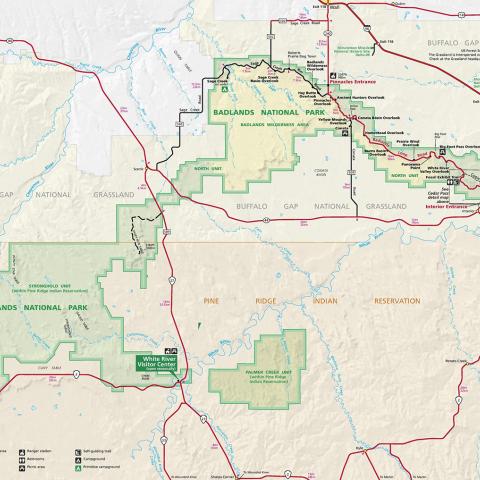
Breathtaking sunsets await travelers to Badlands National Park/NPS, Larry McAfee
Eerily eroded "badlands" -- what other word would you use to describe these naked hills? -- are front and center in Badlands National Park, evidence of the harsh environment and the poor soils. But there's more geology to the Badlands than just its namesake hills.
True, you have the "Yellow Mounds," slight mounds colored yellow by the severely weathered soils. It's a landscape that began to take form 69 million years ago when this part of the country was underwater, covered by an ancient sea. Once the waters drained away, rivers and floods added more sediment, and over the eons the rippled and eroded landscape you see today arose.
Within this landscape, too, are bits and pieces of ancient life that once roamed here. Back in 2010, a 7-year-old visitor to Badlands spied a partially exposed fossil that turned out to be the skull of a 32-million-year-old saber-toothed cat. Kylie Ferguson was attending a Junior Ranger program at the park that year when she thought she saw a fossil in a hillside near the Ben Reifel Visitor Center.
Not long after the fossil was spotted, park paleontological technicians removed the fossil and surrounding rock matrix to protect the find from damage or theft. Upon examination, it was determined that the find was the fossilized skull, lower jaw, and vertebrae belonging to an extinct saber-toothed cat, known scientifically as Hoplophoneus.
Visit Badlands and you'll come away with a little better understanding of some of the conditions the homesteaders of the 19th century and early 20th century faced and endured. The winds can be merciless, as Traveler contributor Lee Dalton noted during a 2013 visit. "The wind is relentless, and it’s not hard to understand how so many of the people who busted sod in this open land commented that the wind could drive one mad," he wrote. "It did drive some to madness, in fact. It was a harsh land then that isn’t any less unforgiving today for those who come unprepared."
And yet, Badlands is a fascinating place. Geogically rich, and harboring paleontological treasures, the park in western South Dakota is home to some bison, enough rattlesnakes to make you very carefully place your feet and hands while exploring the park, and flush with solitude.
Writer Bryan Hansel found the park practically all to himself during a winter visit that left him in awe of the landscape.
Badlands National Park in South Dakota is about an hour east of the Black Hills and Rapid City. Its 244,000 acres protect a mixed-grass prairie and 26- to 75-million-year-old sediment eroded into spires, buttes and rugged cliffs. It also contains one of the richest fossil beds in the world. Almost any hike into the formations yields a fossil. The park instructs you to leave them in place and report your finds. On my first, we found a skull, a leg bone of a 35-million-year-old horse-like mammal, and an almost complete tortoise with leg and neck bones sticking out of its shell. We reported our finds and later heard back about what animals they were from.
The park itself is divided into several units. The North Unit is the most popular. It’s popular because it’s close to the Interstate and it has a road, the Badlands Loop Road, running straight through it. The Stronghold Unit located within Pine Ridge Indian Reservation has no roads and Palmer Creek Unit is surrounded by private property. The ease of access to the North Unit makes it the most popular and usually the busiest.
If you like parks "in the raw," Badlands National Park should definitely be on your travel agenda.
Traveler's Choice For: Geology, solitude, hiking, wildlife, inspiring future paleontologists.




 Support Essential Coverage of Essential Places
Support Essential Coverage of Essential Places







Comments
The geology is certainly front-and-center in this unique park, but I was almost more impressed with the array and abundance of wildlife to be found here. A couple summers ago I came in from the west late in the day and crashed at Sage Creek. It didn't look like much at first, apparently just an expanse of empty grasslands. A cursory exploration before dusk, however, revealed intricate erosion and geologic exposures around the creeks as well as large numbers of prairie dogs, pronghorn, and bison. Although the geologic wonders that revealed themselves while heading east the next day were wonderful, the amount of wildlife in the sparsely-visited western end of the park was never again rivaled on the rest of the visit.
Badlands NP is truly one of the "best-kept secret" National Parks. I live just a couple hours away (nearby Black Hills) and love going there alone or with my family. Great combination of easily-accessed trails and more remote areas where you will be on your own almost any time of year (be prepared). Extra fun for kids as you can almost always find fossils (that you leave behind of course) in the eroding formations. If not, there's an entire "Fossil Exhibit Trail" devoted to this feature. As mentioned in the previous comment, lots of easily-viewed wildlife, also bighorn sheep have been along the loop road the past couple of years. Hope you enjoy it sometime. Mt. Rushmore National Memorial is about 90 min. away, Wind Cave NP and Jewel Cave NM as well, and Devil's Tower NM maybe 3 hours off so you can see a lot around the Black Hills. End of tour...I live here and do love it.
The Fossil Exhibit Trail was a pretty cool showcase. I had heard bighorn sheep were present, but so far I've only seen them at Glacier, Rocky Mountain, and Valley of Fire SP in NV.
On my visit I also stopped at Mt. Rushmore, Wind Cave, and Devils Tower, but time constraints prevented me from seeing Jewel Cave. On the plus side it gives me an excuse to return to this spectacular area.